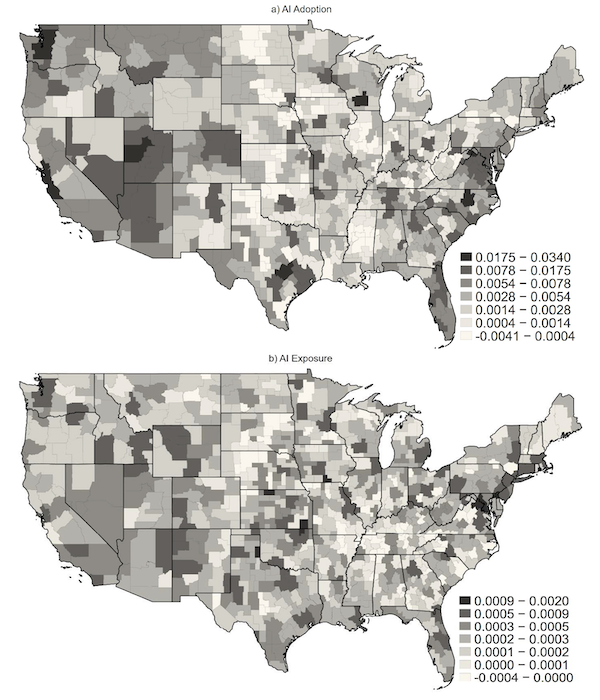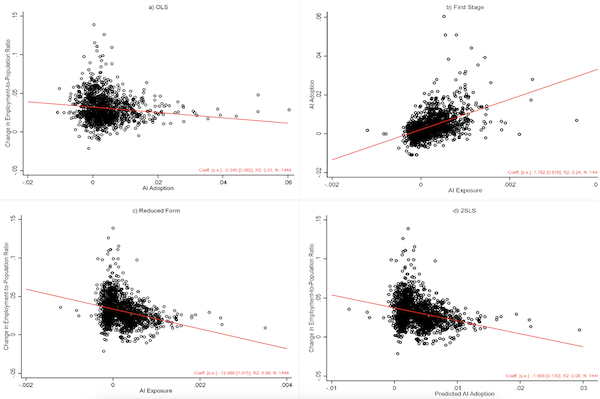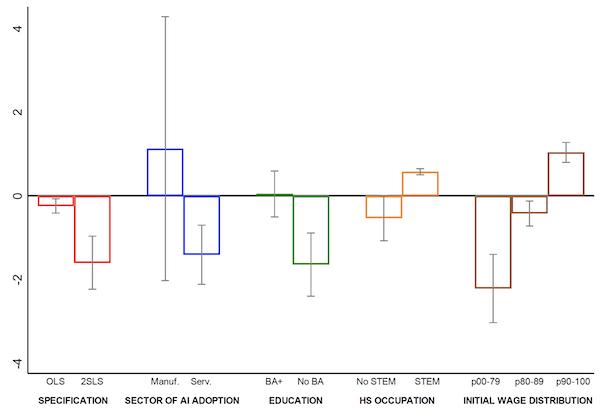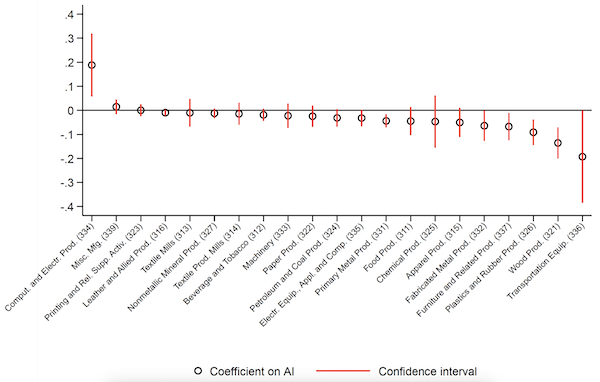Lamebert here: Whaddaya know.
By Alessandra Bonfiglioli, Professor of Economics (on leave) at Queen Mary University Of London, Rosario Crinò, Professor of Economics at University Of Bergamo, Gino Gancia, Fellow, International Trade and Regional Economics, and Ioannis Papadakis, Research Fellow at University Of Sussex. Originally published at VoxEU.
Harnessing the potential of artificial intelligence has become one of the top priorities for policymakers around the world. Yet, doing so first requires a thorough understanding of the effects of these technologies on labour markets. Using data across US commuting zones over the period 2000-2020, this column presents evidence that AI adoption has reduced employment, except in high-paying occupations and those requiring a degree in STEM disciplines.
Artificial intelligence (AI) is often viewed as one of the most transformative and disruptive technologies of recent times (see early Vox columns by Baldwin 2018 and Bughin 2017). Thanks to improvements in machine learning techniques and the growing availability of vast amounts of digital data, the last two decades have witnessed a tremendous increase in the use of AI applications, which include web search engines, targeted advertising, recommendation systems, generative or creative tools, and chatbots. A pressing policy question is how these advances will affect labour markets and especially employment. On the one hand, intelligent tools promise to enhance human capabilities and create new demand for certain skills (e.g. Brynjolfsson et al. 2023, McKinsey Global Institute 2017). On the other hand, AI may surpass workers in decision-making tasks and make them redundant, or it may fuel automation (Acemoglu 2022, Acemoglu and Johnson 2023). Whether AI will complement or substitute workers is therefore an empirical question, for which there is still little systematic evidence.
In a recent work (Bonfiglioli et al. 2023), we study the employment effect of the early phase of AI adoption, exploiting variation across US Commuting Zones (CZs) over the period 2000-2020. Taking a broad definition of AI as algorithms applied to big data, its diffusion started in the early 2000s and accelerated after 2010. While our sample predates the development of large language models such as ChatGPT, it nevertheless covers the rise of the digital economy and of all the major companies involved in big data collection, such as Amazon, Google, and Facebook.
Measuring AI Adoption Across US Commuting Zones
Our analysis faces two challenges. The first is that AI adoption is difficult to measure, as there are no official statistics available to date. However, the use of AI technologies requires workers with very specific programming skills. Leveraging a novel section of the O*NET database – “Hot Technologies” – we classify AI-related occupations as those whose job postings most frequently require software used for machine learning and data analysis. Our baseline classification of AI-related occupations comprises 19 titles, such as data scientists, computer programmers, software developers, and web designers. Then, we detect AI adoption from the growth in the relative importance of these AI-related occupations. A second challenge in identifying causal effects is that AI adoption might be correlated with other shocks that may affect employment. To overcome this problem, we use a shift-share instrument, AI exposure, that combines industry-level AI adoption for the US with pre-adoption CZ-level employment shares across industries. This allows us to identify CZs more exposed to AI as those specialized in industries that experienced faster growth in AI-related occupations nationwide.
Between 2000 and 2020, the employment share of AI-related occupations has almost doubled in the US, rising from 0.14% to 0.20%. Most of this increase has taken place after 2010. There are sizable differences in the diffusion of AI technologies across industries. AI adoption is most prevalent in the service sector, especially in advanced branches such as information, professional, scientific and business services. It is also important in some utilities, such as electricity, and in some areas of the public sector, such as national security and international affairs. Conversely, AI adoption is still limited in manufacturing. This feature distinguishes AI adoption from the use of industrial robots, which is mostly concentrated in the manufacturing sector (Acemoglu and Restrepo 2020).
Figure 1 presents colour maps showing how AI adoption (panel a) and AI exposure (panel b) vary across US CZs, with darker colours representing higher levels of adoption or exposure over the sample period. Negative values are very rare (only 6% of CZs), implying that the deployment of AI technologies has been a widespread phenomenon in the US over the last two decades. Interestingly, our measure of AI adoption (panel a) is very effective at capturing the diffusion of AI both in expected places such as Boston, Seattle, and Silicon Valley, and in new high-tech hubs such as Boulder, Bozeman, and Salt Lake City. Our measure of AI exposure (panel b) removes the variation in AI adoption that is more likely to be driven by contemporaneous CZ-level shocks, which may confound the estimation.
Figure 1 AI Adoption and AI Exposure in US Commuting Zones

Source: US Census and American Community Survey.
Notes: The top map plots the average value of the measure of AI adoption in each CZ between the decades 2000-2010 and 2010-2020. The bottom map plots the corresponding values of the measure of AI exposure.
The Negative Effect of AI Adoption on Employment
Figure 2 provides a graphical representation of our empirical strategy and main results. The dots in each of the four scatter plots represent observations for each CZ and decade (2000-2010 and 2010-2020), while the red line is the linear regression line. Panel a (OLS) documents a negative correlation between AI adoption and the decadal change in the employment-to-population rate at the CZ level. Panel b (first stage) confirms that AI exposure is a strong predictor of AI adoption and, thus, a powerful instrument for the deployment of these technologies. Panel c (reduced form) shows that AI exposure is strongly negatively correlated with employment growth. Finally, panel d (2SLS) plots the relationship between AI adoption, as predicted by AI exposure, and the decadal change in the employment rate, highlighting a strong negative (causal) effect of AI adoption on employment growth. Overall, these graphs show that CZs specialised in sectors experiencing a boom in AI-related employment had stronger rates of AI adoption, which in turn caused them to suffer a relative slowdown in employment. Quantitatively, our estimates imply that if the CZ with average AI adoption over the sample period had hypothetically had no adoption at all, its employment rate would have grown by 0.6 percentage points more.
Figure 2 AI Adoption, AI Exposure and Employment in US Commuting Zones

Notes: The estimation sample consists of 722 CZs observed over two decades, 2000-2010 and 2010-2020. In each plot, an observation is a CZ x decade pair. Predicted AI Adoption is the fitted value of the measure of AI adoption from the first-stage regression in Plot b).
These results are robust to controlling for several additional labour market shocks, such as import competition from China (Autor et al. 2013), the adoption of industrial robots (Acemoglu and Restrepo, 2020), and the increased usage of ICT. They also hold when using alternative definitions of AI-related occupations and when controlling for outliers in various ways.
Figure 3 shows how the relationship between AI adoption and employment growth varies across specifications. The figure conveys three main results. First, the effect of AI adoption is much stronger when AI adoption is instrumented using AI exposure (2SLS versus OLS specification), suggesting that confounding factors tend to mask the negative impact of AI on employment. Second, the effect of AI is driven by adoption in the service sector, where the deployment of these technologies is more prevalent. Third, workers without a college degree are the most negatively affected by AI adoption. Conversely, the only workers to benefit from AI adoption are those in occupations requiring a STEM degree and those in the top 10% of the income distribution.
Figure 3 Heterogeneity

Notes: The figure reports estimated coefficients and 90% confidence intervals on the measure of AI adoption from different specifications. The estimation sample consists of 722 CZs observed over two decades, 2000-2010 and 2010-2020.
Our results also show that the negative effect of AI adoption is not limited to the service sector but also extends to employment in manufacturing, where the use of these technologies is still limited. Specifically, the manufacturing sector accounts for almost 45% of the overall impact of AI adoption on employment, against 60% for the service sector. To shed light on the mechanism underlying these spillovers, Figure 4 reports the estimated effects of AI adoption on employment in the different manufacturing industries. The figure shows that workers in industries characterised by high automation intensity, such as transport equipment and wood products, are especially hard hit. This suggests that AI adoption in services may, in fact, be used for the automation of jobs in manufacturing.
Figure 4 AI Adoption and Employment in Individual Manufacturing Industries

Notes: The estimation sample consists of 722 CZs observed over two decades, 2000-2010 and 2010-2020.
Conclusions
Recent improvements in the field of AI have triggered much hype about the future of work. While nobody can predict the exact direction that new innovations and applications will take, we think that it is important to start from understanding the consequences that these technologies have already had. Our results point toward robust negative effects of AI adoption on employment for most workers and sectors. While more micro-level evidence is needed to precisely identify the mechanism through which these negative effects unfold, our evidence is nevertheless consistent with the view that AI is contributing to the automation of jobs and to widening inequality.














